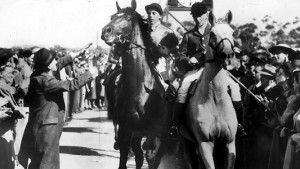The Greatness of Bernborough
By Harley Walden
We have highlighted the Spring’s of the 1920s and 1946 in Sydney but the Spring of 1946 in Melbourne was not without its controversy.
Punters and the horse lovers – moved slowly in dozens of queues outside the entrance gates at Caulfield to see a champion and finally a record 108,123 people were jammed into the course.
It was later estimated that at least one third of the crowd were attending the races for the first time and had been attracted only by the appearance of Bernborough.
He was the 7/4 favourite after opening at twos on the strength of having won 15 races in a row, and there was an air of confidence that the tally would be 16 by day’s end.
The peoples champ was the cynosure of all eyes as Mulley we legged aboard and his mount led the parade onto the track, and the heart of one particular punter beat faster as the countdown to race time progressed.
Her name was Johanna Pauline Taks and she had been dubbed by the press as The Women in Black, a sobriquet matching her penchant for wearing sombre, although always elegant, attire as she followed Bernborough from course to course, blindly plunging on him wherever and whenever he races.
She once wagered £4500 on him to win £450, and always bet in cash and carried her money in a black bag.
The horse’s 15-straight wins had steadily multiplied her bankroll, and Taks, an Estonian immigrant, was supremely confident that the horse she adored would not let her down.
Benborough appeared to have no hope of finding a path through the 28 runners.
Mulley exhausted every possible avenue but kept finding brick walls.
The favourite was back in the field for most of the trip, as usual, and luck was against him every time the jockey sought to drive him through an openings.
He came home wide on the track with a wing on every foot but, having been buffeted under his big weight when angling for two runs in the straight, could only finish fifth.
Deep disappointment was felt within the ranks of more than 100,000 onlookers who were crushed against each other as tight as sardines in a tin.
There was a polite ovation for the winner, Royal Gem, and Harry Plant was reported as trembling with rage as Bernborough was ridden back to scale.
It was the blackest afternoon of George Mulley’s topsy-turvy career, the afternoon when Plant, the man he had always called a friend, accused him of riding the great horse dead.
Mulley never again rode Bernborough or any other horse prepared by Plant, and later relentlessly vilified the jockey whenever discussions on the subject of the Caulfield Cup arose.
It was a tragedy for Mulley and a slur on him as a man and a professional jockey, but Plant was to remain unwavering in the belief that his jockey had been got at by the bookmakers.
Mulley carried this burden as bravely as he could but the pain was always close to the surface.
In the eyes of some-particularly those close to Plant-Mulley was without doubt the wrongdoer and they slandered him and smeared him in the ensuing days and weeks, and in the years that followed.
To this day there are men in Sydney who still share the trainer’s view.
But in the eyes of most, the exceptionally gifted Mulley had been a scapegoat, a victim of circumstances who didn’t get the breaks when they were most needed and who was riding a horse lugging too much weight against too many classy rivals.
It may also be said in the defence of Mulley’s ride that the VATC stewards had scrutinised his every twitch during the run and had no post-race questions to ask or comments to offer.
The fact that the men with the power to confiscate the jockey’s licence had been satisfied with Mulley’s endeavour and tactics should have been seen by Plant and Romano, as well as anyone else who knew how to adjust a pair of binoculars.
Meanwhile, The Women in Black, who had lost her entire bank of £6000 on Bernborough, told a reporter immediately after the race that she was going straight home.
“I have a headache,” she said, and was not reported again as having been seen on a racecourse
With the exception of herself the punters rallied once more when Bernborough lined up for the L.K.S. MacKinnon Stakes at Flemington and on paper-with only 9st 3lb under WFA scale-he was entitled to be sent out as the 4/1 on hotpot.
Several furlongs out he was travelling beautifully behind Sydney mare, Flight, but was distracted by a crossing on the track, Bernborough, now ridden by Billy Briscoe, shied at the crossing. It happened in an instant.
At one moment the horse was strutting his stuff and at the next he was the victim of a displaced sesamoid and a severely torn ligament.
Just like that.
Flight went on to win the race while Bernborough skidded to a halt.
Briscoe dismounted and lead the limping horse back to a small enclosure.
Plant, quickly joined him, a few minutes later they were joined by Romano, the owner of the most famous racehorse in Australia, he patted Bernborough’s nose and said: “Bad luck, boy, that it should end like this.”
Heartfelt relief spread through the vast crowd with the announcement that the leg would be set in plaster and that Bernborough would be able to carry out stud duties.
It is a racing truism that only champions can cope with the weight conditions of handicaps.
Bernborough’s finest achievements came not at WFA but through handicaps, and many years after the dramas of 1946 George Mulley had this to say about him: “I think the secret was not that he could gallop but that he was a great weight carrier.
Weight didn’t matter to him.
He was one of those horses that they couldn’t handicap.
That was the greatness of Bernorough.
 scone.com.au
scone.com.au
